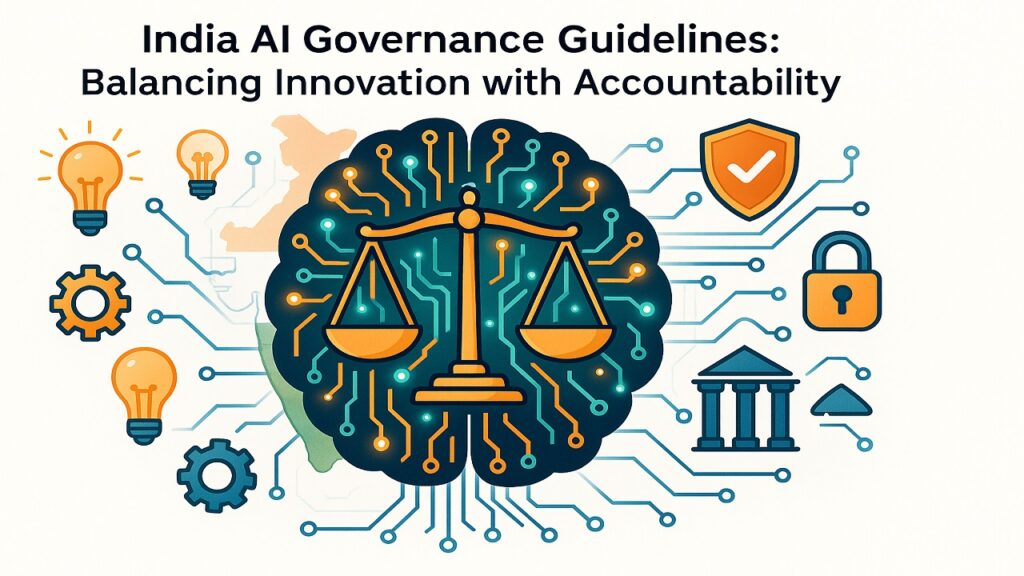India AI Governance Guidelines : Balancing Innovation with Accountability
Context:

- The Ministry of Electronics & IT (MeitY) has released the India AI Governance Guidelines, a national pro-innovation framework.
- Purpose: To enable safe, trusted, and responsible AI adoption across sectors while supporting India’s long-term development vision, Viksit Bharat 2047.
- These guidelines are drafted by a committee constituted in July 2025 for MeitY and aim to balance rapid AI adoption with accountability, fairness, and safety, without imposing an overarching AI law.
1. Overview of India AI Governance Guidelines
- Nature: A four-part governance blueprint to manage AI adoption safely.
- Aim: Democratize AI benefits while mitigating risks such as deepfakes, bias, and security threats.
- Approach: Agile, sector-specific governance rather than one-size-fits-all regulation.
2. Key Features
A. Seven Sutras (Principles):
- Trust – foundation for adoption.
- People First – human-centric AI design.
- Innovation over Restraint – encourage experimentation with risk management.
- Fairness & Equity – prevent bias, promote inclusivity.
- Accountability – clear responsibilities across roles.
- Understandable by Design – AI outputs must be interpretable.
- Safety, Resilience & Sustainability – build robust and sustainable AI systems.
B. Six Pillars of Governance:
- Infrastructure – access to data, compute, and tools.
- Capacity Building – training personnel and regulators.
- Policy & Regulation – sector-specific rules, agile legal interventions.
- Risk Mitigation – standards, protocols, and tools.
- Accountability – graded liability, transparency, grievance mechanisms.
- Institutions – AI Governance Group (AIGG) and AI Safety Institute (AISI).
C. Action Plan with Timelines:
- Short/Medium/Long-term steps for standards, incident systems, sandboxes, legal gap-fixes, and DPI-AI integration.
D. Institutional Architecture:
- AI Governance Group (AIGG): Central oversight body.
- Technology & Policy Expert Committee (TPEC): Advisory function.
- AI Safety Institute (AISI): Testing, standards, and safety R&D.
E. Pro-Innovation Regulation:
- Targeted amendments to existing laws rather than a new AI Act:
- IT Act classifications
- Copyright & TDM provisions
- DPDP (Data Protection) rules
F. Risk Management Tools:
- India-specific AI risk taxonomy
- AI incident database
- Voluntary commitments
- Techno-legal solutions: watermarking, provenance, privacy-enhancing tech, DEPA-style consent
- Human-in-the-loop for high-risk AI scenarios
G. Accountability Levers:
- Graded liability by role and risk
- Transparency reports, peer and auditor oversight
- Grievance redressal mechanisms
H. Enablement at Scale:
- Equitable access to compute/data (AIKosh, subsidized GPUs)
- DPI-first solutions
- Incentives/toolkits for MSMEs
3. Need for Strong Guidelines
- Emerging Risks: Guardrails against deepfakes, CSAM, bypass-prone authentication, and national-security implications.
- Trust as a Precondition: Understandable disclosures and accountability essential for AI adoption at scale.
- India-specific Context: Provisions consider multilingual realities, last-mile access, and vulnerable populations, ensuring inclusive and scalable AI.
4. Challenges
- Regulatory Coherence: Align liability under IT Act, DPDP rules, and sectoral laws.
- Copyright & Training Data: Balance innovation-friendly text-and-data-mining with creators’ rights.
- Content Authentication Limits: Watermarking and forensic tools aid provenance but are not foolproof and may affect privacy.
- Capacity Gaps: Need trained regulators and institutional capability to avoid overburdening MSMEs.
- Data/Compute Access: Inclusive AI requires representative Indian datasets and affordable evaluation compute.
- Incident Reporting Culture: Build a tiered AI-incident system with incentives for transparent reporting.
5. Way Forward
- Institution Building: Activate AIGG and TPEC, fully resource AISI, and issue a master circular mapping laws and responsibilities.
- Codify Standards: Develop guidelines, codes, metrics, testing frameworks, and sandbox experiments in sensitive sectors.
- Close Legal Gaps: Targeted amendments on classification, liability, and DPDP interfaces, keeping enforcement sector-led.
- Capacity Development: National-level skilling and awareness campaigns for compliance.
- Operationalize Safety: Launch AI incident databases, grievance mechanisms, and proportionate provenance/authentication.
- DPI + AI at Scale: Leverage DPI for inclusive, privacy-preserving AI services.
- Global Engagement: Represent India in international AI safety networks to shape interoperable norms.
Conclusion
- The India AI Governance Guidelines provide a responsible, innovation-led AI framework anchored in trust, safety, and inclusion.
- By combining flexible governance with sectoral accountability, India seeks to balance technological progress with protection.
- Effective implementation can make AI a cornerstone of Viksit Bharat 2047, ensuring technology remains human-centric, ethical, and empowering.
Source : Sansad TV
